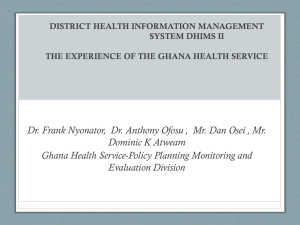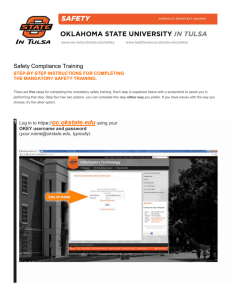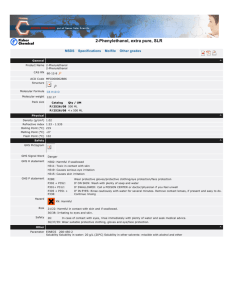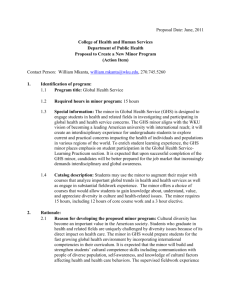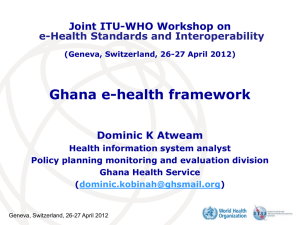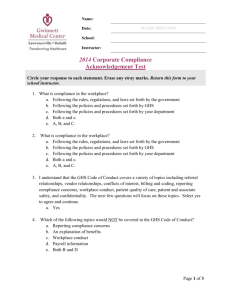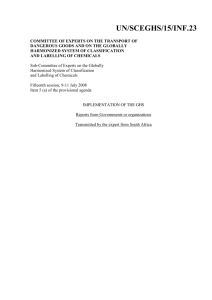Addressing health information gaps in Ghana
advertisement
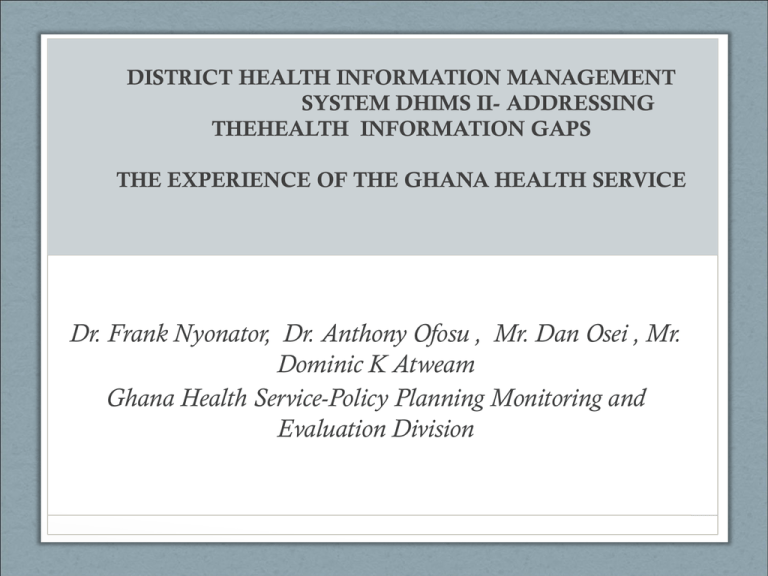
DISTRICT HEALTH INFORMATION MANAGEMENT SYSTEM DHIMS II- ADDRESSING THEHEALTH INFORMATION GAPS THE EXPERIENCE OF THE GHANA HEALTH SERVICE Dr. Frank Nyonator, Dr. Anthony Ofosu , Mr. Dan Osei , Mr. Dominic K Atweam Ghana Health Service-Policy Planning Monitoring and Evaluation Division Outline of presentation • HMIS Challenges • ICT Solutions • Requirements and Security • Innovation • Lessons learnt • Conclusion HIMS Challenges • Obtaining routine service data (USEFUL DATA) from all health facilities across Ghana has been the single most immediate challenge of the health sector • USEFUL DATA for health managers at all levels for planning, budgeting and decision-making has not been timely or complete. • Difficulty in tracking both reporting and non-reporting facilities • Greater challenge for monitoring and evaluation activities of the sector. • This culminates in the slow response of GHS in addressing potential health emergencies and epidemics and planning based on estimates. ICT Solution • GHS Collaborated with the University of Oslo developed a software called the District Health Information Management System (DHIMS2) • DHIMS2 is a comprehensive HMIS solution for the reporting and analysis needs of district health administrations and health facilities at every level. It’s been designed to • Provide a comprehensive HMIS solution based on data warehousing principles and a modular structure which can easily be customized to the needs of different health systems - national, regions, districts, and facilities • DHIMS2 is centralized, which enables easy, online updates and deployment of the application. ICT Solution-Accessibility • DHIMS2 is accessible in all 170 (216) districts and is being used by health facilities and district health directorates to collect, collate, transmit and analyze routine health service data. • All staff in District Health Directorates and health facilities with the required capacity for DHIMS2 management has been registered as secure users on the DHIMS2 server. • There are currently 5,563 registered users from government, quasi-government, private and faith-based facilities that are submitting their service report each month. Requirement & Security • The only requirements for the user is to have a web browser installed on a computer and have an Internet connection. • To access DHIMS2 you do not need any software to be installed on your computer. It works independent of the operating system on your personal computer. • Data is encrypted , SSL certficate authentication • Requires strict user guide line Personalized Dashboard that Managers can track their service data of interest Quick reports for managers INNOVATION • GHS ensured in-house capacity building and development of DHIMS2 application . • All modifications done on the DHIS2 platform to adapt it for GHS use as DHIMS2 were accomplished by our own staff, trained by a TA ‘s from the University Of Oslo. • We have accomplished a nationwide implementation of a web-based data collation and reporting system involve private, quasi government and government facilities without an initial pilot project. Implementation • GHS to date has trained 5 health workers in each of the 170(216) districts (850 health workers), 180 system administrators across the 10 Regional Health Directorates and all 170(216) District health directorates to support the use of DHIMS2 in collecting and collating health service data. • Senior Managers at the headquarters level, Regional and district level have also been trained and all now use DHIMS2 to monitor the service utilization and inputs as well as to generate their own reports due to the real time data on DHIMS2 LESSONS LEARNED • When routine health service data is visible, easily available and accessible on a common platform for all managers it leads to improvement in Data Quality. • Dealing with the Human Factor and Change management are the most important challenges to overcome when putting in a technology to address service delivery bottlenecks CONCLUSION • Introducing DHIMS2 into the Health Sector has so far been successful in mitigating the challenges with service data collection and reducing the information transmission bottlenecks and timeliness. . Integrated architecture of interoperable systems Integrated architecture of interoperable systems and infrastructures (paper, computers, internet, mobiles telephones Replicated at each administrative level: • National • Regional • District Data Warehouse Reports, GIS, Pivot, Graphs etc Data from/to mobile phones Data capture from Paper reports Import e data Household Tracking Export e summary data Logistics MIS Open LMIS Human Resource Records iHRIS Monthly summary Reports Medical Records Open MRS Telephone Register pregnant women and immunization
